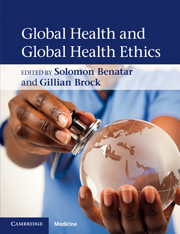Book contents
- Frontmatter
- Contents
- List of contributors
- Introduction
- Section 1 Global health, definitions and descriptions
- Section 2 Global health ethics, responsibilities and justice: some central issues
- Section 3 Analyzing some reasons for poor health
- 12 Trade and health: the ethics of global rights, regulation and redistribution
- 13 Debt, structural adjustment and health
- 14 The international arms trade and global health
- 15 Allocating resources in humanitarian medicine
- 16 International aid and global health
- 17 Climate change and health: risks and inequities
- 18 Animals, the environment and global health
- 19 The global crisis and global health
- Section 4 Shaping the future
- Index
- References
14 - The international arms trade and global health
Published online by Cambridge University Press: 01 March 2011
- Frontmatter
- Contents
- List of contributors
- Introduction
- Section 1 Global health, definitions and descriptions
- Section 2 Global health ethics, responsibilities and justice: some central issues
- Section 3 Analyzing some reasons for poor health
- 12 Trade and health: the ethics of global rights, regulation and redistribution
- 13 Debt, structural adjustment and health
- 14 The international arms trade and global health
- 15 Allocating resources in humanitarian medicine
- 16 International aid and global health
- 17 Climate change and health: risks and inequities
- 18 Animals, the environment and global health
- 19 The global crisis and global health
- Section 4 Shaping the future
- Index
- References
Summary
Introduction
Despite the superficially friendly and respectable face of the world's current arms business, it remains as murky, secretive and amoral as it has always been. This secretive and destructive network of producers and traders of arms continues to be the driving force, and at times the initiating force, of many modern-day global conflicts in which civilians are the main victims (Burrows, 2002).
Until the Second World War, civilian deaths were a relatively small percentage of total deaths in conflicts (about 14%). But this classical face of conflict was changed by the mass murder of civilians in the Second World War. The genocidal campaigns against Jews, Roma and other distinct groups, together with the bombings of cities such as London, Dresden and Tokyo, and the use of nuclear bombs on Hiroshima and Nagasaki, brought civilians to the forefront of conflicts unlike any other conflicts in previous times. The nuclear bombs alone killed some 200,000 civilians instantly and caused physical and psychological damage to many more which continues even today (Coupland, 1996).
The trend towards mass killing and genocidal campaigns against civilians did not end with the Second World War, and to date civilians continue to be the main victims of conflict around the world.
Since the end of the Second World War, conventional weapons have been responsible for the deaths of more than 30 million people. The ongoing trend in escalating civilian deaths in modern-day conflict is extremely alarming.
- Type
- Chapter
- Information
- Global Health and Global Health Ethics , pp. 166 - 172Publisher: Cambridge University PressPrint publication year: 2011
References
- 1
- Cited by



